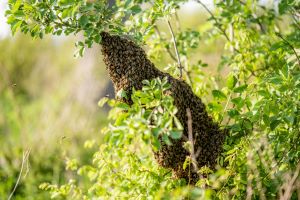It can be both fascinating and frightening to discover that you have a bee colony in your yard. You might have found a little hive settled into a nook in the tree or a brood box full of activity under the eaves. No matter what could be the case, care and some know-how are called for. Confidence will come from this guide in the buzzing world of the unexpected apiary and help you to make the right decision as to the next step to take.
Identifying the Hive
First, in order to do an effective bee and bee nest removal, confirm that you’re actually dealing with bees and not wasps or hornets. Honeybees are generally fuzzy and round-bodied, while wasps and hornets are sleeker.
Bees also construct their homes using wax, creating intricate beehive frames within a hive body or wooden box. Wasps, conversely, build papery nests.
Note that you might encounter different types of hives, too. They include:
Natural hives
This type of bee hive is often found in hollow trees or wall cavities.
Managed hives
These could be Langstroth hives (stacked boxes), top bar hives, or other beehive designs used by beekeepers.
If you see a cluster of bees hanging from a branch, it’s likely a swarm – a temporary stop for bees seeking a new home. Swarms are usually docile and move on within days. However, consistent bee traffic in and out of a fixed location suggests an established colony.
Safety First
Upon discovering a hive, resist the urge to investigate closely. Bees can interpret quick movements or loud noises as threats, potentially triggering defensive behaviour.
Keep children and pets at a safe distance as well. If the hive is near a frequently used area, consider temporarily adjusting your routines to avoid unnecessary interaction with the bees.
To Bee or Not to Bee: Assessing the Situation
Next, take a moment to consider the hive’s location and potential impact. Is it in a high-traffic area? Could it pose a danger to people with bee allergies? Or is it in a secluded spot where it’s not causing harm?
While bees aren’t legally protected in most areas, many people recognize their crucial role in our ecosystem as pollinators. If the hive isn’t posing an immediate threat, leaving it alone might be the best course of action.
When to Call in the Pros
Removing a bee hive is a job best left to professionals. Here’s why:
Safety
Bee stings can be dangerous, especially in large numbers or for those with allergies.
Effectiveness
DIY removal often fails to completely eliminate the colony, leading to re-infestation.
Conservation
Professional beekeepers can often relocate the hive, preserving the bee population.
Consider professional removal if:
- The hive is inside your home’s structure
- You or a family member has a bee allergy
- The hive is in a high-traffic area
- You’ve noticed aggressive behaviour from the worker bees
Professionals can safely remove bees without killing them. What they’ll do instead is relocate the bees to ensure they don’t harm anyone.
Finding the Right Help
It’s also important to look for a beekeeper or a company truly specializing in bee removal. These experts often use methods to relocate the hive rather than destroy it, as already mentioned.
Here’s what to expect from a professional bee removal service:
Assessment
They’ll inspect the colony and surrounding area.
Plan of action
Based on the hive’s location and size, they’ll outline their removal strategy.
Removal
This step might involve carefully cutting into walls if the hive is inside your home.
Clean-up
They’ll remove the honeycomb and seal entry points to prevent future infestations.
Relocation
Many services will move the bees to a new hive, supporting local beekeeping and honey production – a market that’s valued at around USD$8 billion in 2021.
Note that costs can vary widely depending on the hive’s location and size. A simple exterior removal might cost a few hundred dollars, while extracting a hive from inside your walls could be more expensive.
Living in Harmony
Remember, encountering a bee hive doesn’t always spell disaster. In many cases, bees can coexist peacefully with humans, providing valuable pollination services to your garden. If you find a hive in a low-traffic area where it’s not causing problems, consider leaving it be.
However, if you need to have a hive removed, opt for humane removal methods that prioritize the bees’ survival. Many areas have local beekeeping associations that can provide advice or removal services, ensuring the honeybees find a new home where they can continue their important work.
Understanding Bee Behaviour
Knowing a bit about bee behaviour can also help you coexist with them more peacefully:
Swarming
This natural process occurs when a colony grows too large for its current home. A swarm may temporarily rest on a branch or fence while scout bees search for a new home.
Foraging
Worker bees travel up to 3 miles from their hive in search of nectar and pollen. They’re typically non-aggressive when away from the hive.
Defensive behavior
Bees become defensive when they perceive a threat to their hive. It’s more likely to occur close to the hive or if the hive is disturbed.
Seasonal changes
Bee activity increases in spring and summer. You might notice more bees as they build up their honey stores for winter.
Conclusion
Anyone can be shocked by finding a domesticated colony of bees. Still, it’s a situation that can be controlled if you’re alert, level-headed, and aware of when to seek professional help. It’ll help you get through the situation safely and responsibly. Again, bees, although not legally protected, should be kept safe and concerns rendered with respect to the environment.

